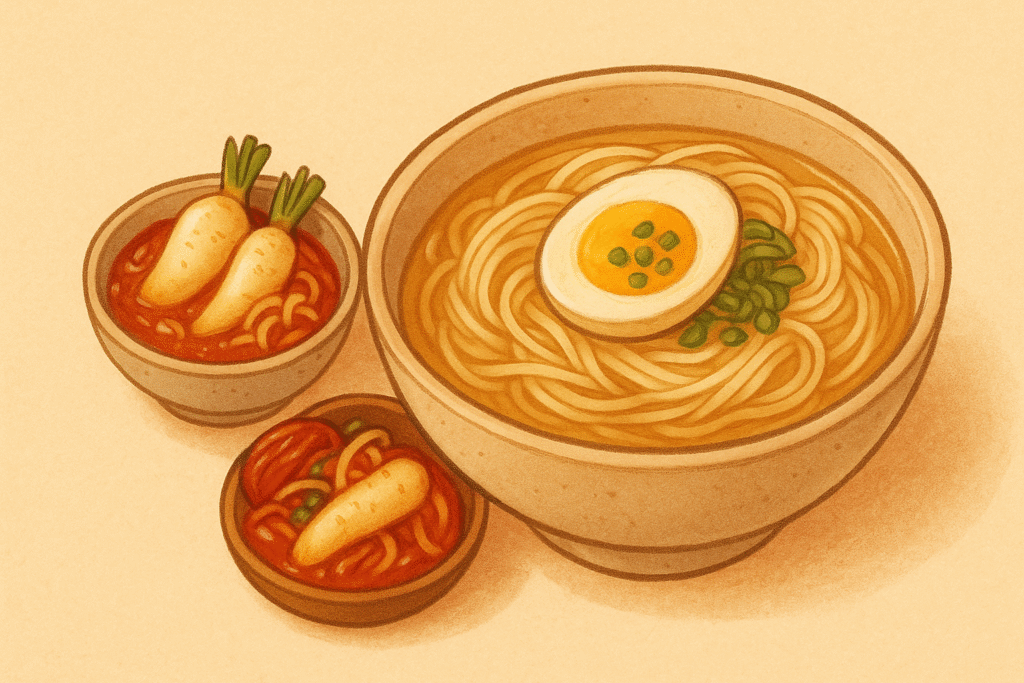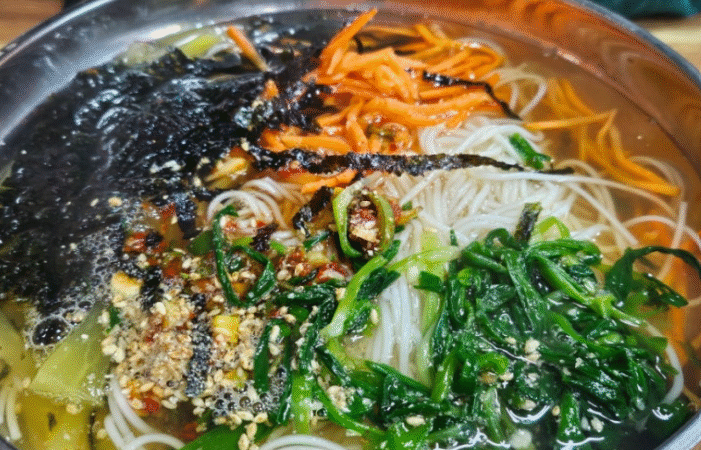Why Boost Eggs in Janchi Guksu?
Traditional Janchi Guksu uses thin wheat somyeon noodles in a clear, light broth—perfect for celebrating long life. But for those focused on protein and satiety, adding extra eggs is a smart upgrade. The addition of 2–3 thin egg crepes (jidan) per bowl raises protein content without altering the classic flavor—great for muscle support and steady energy.

Ingredients (2 Servings)
Broth Base
- 5 cups water
- 10 large dried anchovies (heads/guts removed)
- 1 piece kelp (dashima, ~10 cm)
- 1 small onion (halved)
- 1 slice Korean radish (mu) (~50 g)
- Salt and light soy sauce (guk-ganjang), to taste
Noodle & Toppings
- 180 g somyeon (thin wheat noodles)
- 2–3 eggs (beaten and cooked into crepes, then julienned)
- 70 g zucchini (julienned)
- 60 g carrot (julienned)
- Optional: seaweed strips, scallions, sesame seeds
Step-by-Step Janchi Guksu Recipe
- Make the broth: Simmer water with anchovies and kelp for 10–15 minutes. Add onion and radish, simmer another 10 minutes. Remove solids. Season with soy sauce and salt for a clean, umami-rich broth.
- Cook the noodles: Boil somyeon 6–7 minutes, stirring gently. To retain chewiness, splash cold water once while boiling and rinse the finished noodles under cold water to remove excess starch.
- Prepare egg crepes: Whisk eggs with a pinch of salt. Cook thin tortillas in a lightly oiled pan. Once set, roll and slice into julienne strips.
- Arrange the bowl: Divide noodles into two bowls. Top with egg crepes, zucchini, and carrot strips.
- Pour hot broth: Ladle the warm broth over noodles and toppings. Garnish with scallions, sesame seeds, or seaweed strips.
Healthy Side Dish Suggestions
- Oi Muchim (Korean cucumber salad): Hydrating, refreshing, with vitamins and probiotics.
- Baechu kimchi: Fermented and probiotic-rich for gut health.
- Steamed or braised tofu (Dubu Jorim): Adds texture and plant protein.
- Mackerel or grilled fish: Provides omega-3s for heart and hormonal health.
Health Benefits of Key Ingredients
- Somyeon (wheat noodles): Historically served at celebrations, symbolizing longevity. Thin and light, they digest easily.
- Anchovy-kelp broth: Rich in minerals and umami, low in fat—hydrates while nourishing.
- Egg (Jidan): Adds high-quality protein (6 g per egg), B vitamins, choline for metabolism and cognitive focus.
- Vegetables (zucchini, carrot): Provide fiber, vitamins A/C, antioxidants, and color.
- Korean radish in broth: Contains digestive enzymes, which enhance nutrient absorption and gut comfort.
- Scallions/seaweed: Add iodine, making it thyroid-friendly and boosting metabolism.
Why This Meal is Great for Wellness & Dieters
- Balanced: Light noodles with broth and protein-rich eggs support digestion and fullness without heaviness.
- Protein-boosted: Extra eggs help maintain muscle mass—crucial during weight loss.
- Seasonal flexibility: Enjoy it warm in winter or lightly chilled in summer—this dish adapts.
- Traditional comfort: Still honors the celebratory spirit of Janchi Guksu, symbolizing happiness and long life in Korean culture.
Enjoy this enhanced version of Janchi Guksu—it’s a balanced blend of tradition, protein, warmth, and comfort. Pair it with light Korean sides, and you’ve got a wholesome, diet-friendly meal for any season. If you’d like an infographic or recipe card next, I’d be happy to create one!
Warm Memories in a Bowl: The Comfort of Korean Janchi Guksu
Janchi Guksu, or “banquet noodles,” is a beloved Korean noodle dish known for its simplicity, warmth, and affordability. Traditionally served at celebrations like weddings or birthdays, it also became a quick, comforting meal for busy workers and market-goers. For many Koreans, it holds memories of stopping by a local food stall during a hectic day and enjoying a hearty bowl for just 2,000 or 3,000 won.
Though prices have risen over time—now around 7,000 to 8,000 won per bowl—it still feels like a humble meal compared to other dining options in Korea. In a time when even 10,000 won barely covers a single meal, Janchi Guksu remains a nostalgic and accessible option. More than just noodles in broth, it symbolizes a simpler time, shared warmth, and the joy of affordable comfort food. It’s a taste that brings back the past with every bite.
